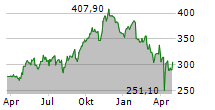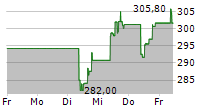
As the climate continues to change, and risks to human health and well-being continue to grow, one critical area demands our attention: the use of energy recovery technology in our cities to decarbonize buildings and transport.
NORTHAMPTON, MA / ACCESS Newswire / April 3, 2025 / This article is authored by Jose La Loggia, Group President, EMEA, Trane Technologies.

As the climate continues to change, and risks to human health and well-being continue to grow, one critical area demands our attention: the use of energy recovery technology in our cities to decarbonize buildings and transport.
Buildings represent more than 30%1 of all emissions, with transport responsible for another 20%2. That's more than half of the world's emissions that Trane Technologies can help address.
To reduce emissions and decarbonize our cities, we must revolutionize energy used in buildings and transport. Any heat released into the environment can be considered wasted, and since it takes energy to produce heat, wasted heat is wasted energy. By preventing and recovering waste heat, we are helping decarbonize buildings, industry and transport systems - transforming them from energy sinks into energy sources.
By focusing on the generated power that's being wasted, what we call demand-side management, we can have a significant impact on addressing energy waste and reducing energy demand.
Energy recovery: a game changer for the built environment
Historically, buildings have relied on fossil fuels and natural gas for their heating and cooling needs. Most buildings have also typically used separate heating and cooling systems that operate independently, causing higher emissions - especially during cooling processes that generate heat, which is typically wasted and released into the atmosphere.
But our vision for the buildings of tomorrow is clear: a future in which renewable energy production, the heating and cooling of buildings and energy storage operate in unison to create highly energy-efficient buildings. Such buildings generate enough energy to run their own facilities without drawing from the grid, re-purposing what would otherwise be wasted while driving significant energy efficiencies. If decarbonized buildings became the norm, we could breathe cleaner air and live in smarter, healthier and more resilient cities that are less reliant on fossil fuels.
The concept of thermal management for temperature control is central to this vision. Energy recovery technology like heat pumps can capture naturally-generated heat as a byproduct, instead of rejecting it into the atmosphere, and repurpose it for another use, such as comfort heating and hot sanitary water. This "free heating" approach translates into substantial cost savings compared to conventional boiler systems. By using heat pumps, building owners and city planners can also integrate heating and cooling systems and draw from another untapped free source of energy: waste heat.
In fact, heat pumps can re-purpose wasted heat to address other heating demands at a building or city level. A prime example of an innovative thermal management system is?Trane Technologies' project in the Dutch city of Aalsmeer. Excess heat from a data center is repurposed to provide hot water to a local school and gymnasium. This project saved Aalsmeer 400 metric tons of CO2 emissions annually - equivalent to the emissions generated from 48 homes. Adopting a simultaneous heating and cooling thermal management system, which can heat and cool at the same time, not only reduces reliance on fossil fuels, but it is also much more efficient.
Driving down carbon emissions in transportation
New industry standards for emissions reduction and efficiency are being set for commercial transportation. Trane Technologies specializes in transport refrigeration, to ensure the safety of foods and medicines - in a sustainable way. The Thermo King AxlePower energy recovery system, for example, harvests energy when a trailer rolls or brakes, capturing and storing the power in a high-voltage battery that powers the refrigeration unit. Such high-performance, hybrid or fully electric systems can make significant CO2 savings.
During a trial on?Woolworths' long-haul N1 route in South Africa, the vehicle's battery operated for a distance of 15,000 kilometers to cool the load and only engaged the diesel engine 3% of the time. On the route between Johannesburg and Cape Town, carbon emissions dropped by 27 tons.
Challenging the current mindset around decarbonization
By now, it should be clear that obstacles to creating decarbonized cities are not technological. So, what is? One common misconception is that sustainable solutions are prohibitively expensive. In reality, the energy efficiency and CO2 reductions achieved through these technologies often result in short payback periods, sometimes within just two to three years.
Another myth is that these systems are complex and only applicable to new building construction. This is far from the truth. Almost 75% of existing building stock in the European Union has a poor energy performance that can be considerably improved with smart heating and cooling solutions3?. When we replace cooling-only machines with those capable of simultaneous heating and cooling, the incremental cost is more manageable. And for fleet owners looking to switch to electric solutions, next-generation energy recovery systems (e.g. Thermo King AxlePower) are also more efficient, less reliant on recharging stations and fossil fuels.
Financing, often perceived as a barrier, is also readily available. The key is to finance the future, not outdated systems.
The future is now: time for action
The path to decarbonizing our cities lies in these sustainable, thermal management and energy recovery solutions. As we move forward, policymakers, industry leaders, and communities must work together to embrace this vision.
Decarbonizing our cities is within reach, and the benefits for our planet and future generations are immeasurable.
A version of this article originally appeared in the Financial Times.
Article Sources (3)
[1] IEA, "Tracking Clean Energy Progress 2023: Buildings," 2023.
[2] IEA, "Tracking Clean Energy Progress 2023: Transport," 2023.?
[3] European Commission Energy Performance of Buildings Directive 2024 and data collected by Trane Technologies.
View additional multimedia and more ESG storytelling from Trane Technologies on 3blmedia.com.
Contact Info:
Spokesperson: Trane Technologies
Website: https://www.3blmedia.com/profiles/trane-technologies
Email: info@3blmedia.com
SOURCE: Trane Technologies
View the original press release on ACCESS Newswire


